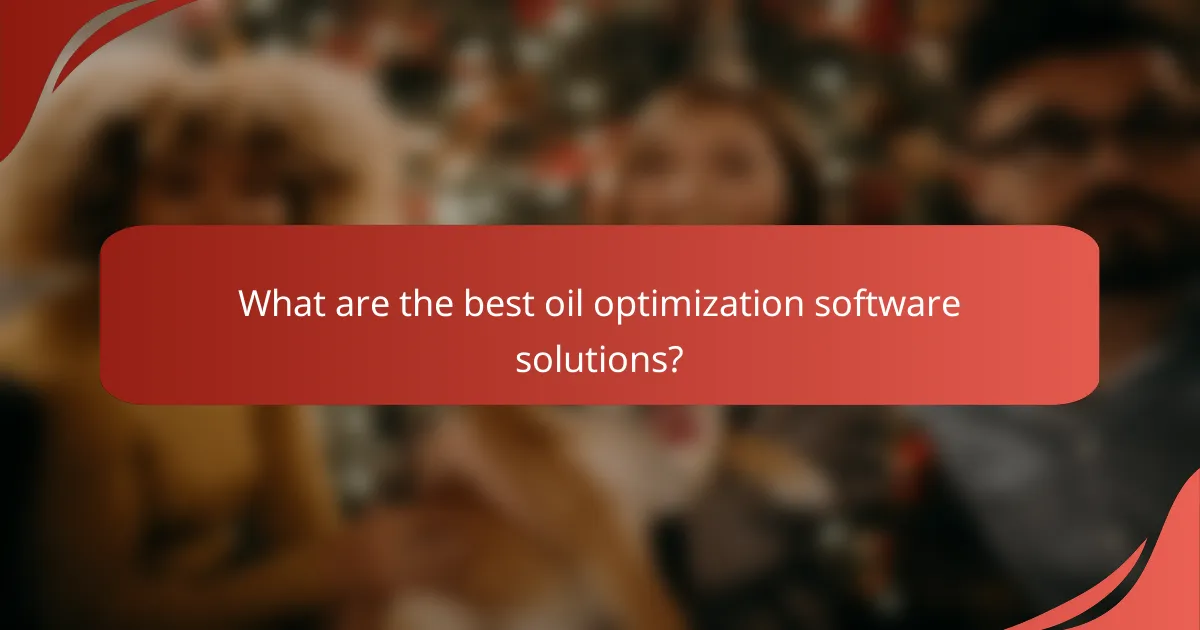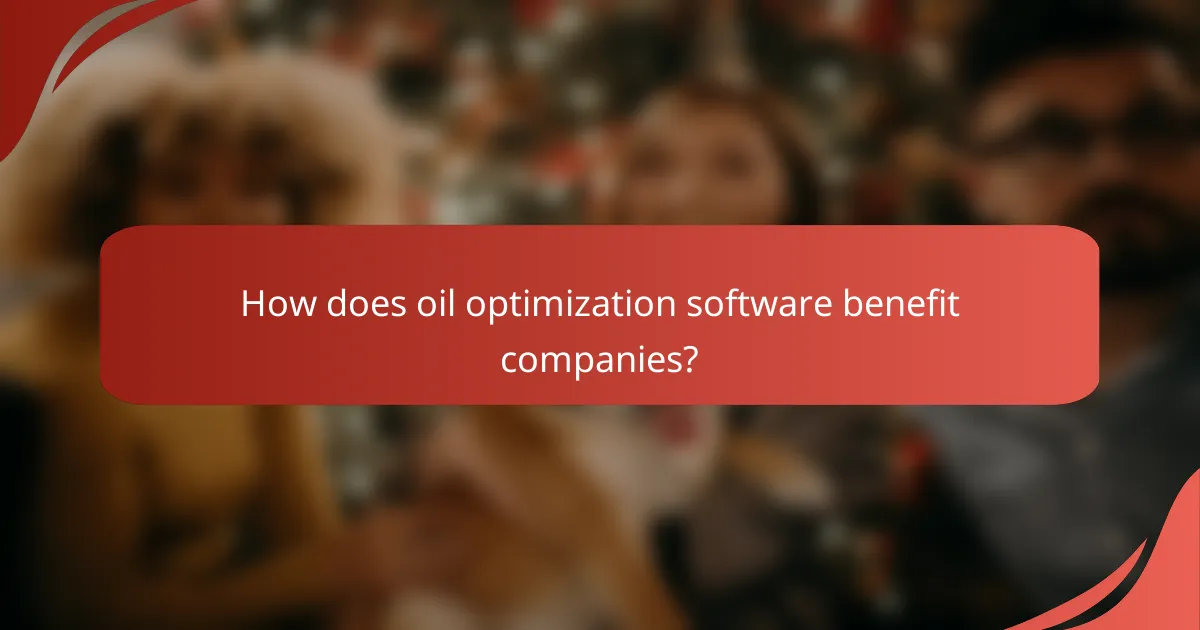Oil optimization software plays a crucial role in enhancing efficiency and reducing costs within the oil and gas industry. By offering features such as real-time data analytics and predictive maintenance, these solutions empower companies to make informed decisions and streamline operations. Selecting the right software can significantly improve operational performance and safety, ultimately driving better outcomes for businesses in this sector.

What are the best oil optimization software solutions?
The best oil optimization software solutions enhance efficiency and reduce costs in oil and gas operations. Key players in this field offer various features that cater to different aspects of the industry, from production management to real-time data analysis.
Schneider Electric’s EcoStruxure
Schneider Electric’s EcoStruxure is designed to optimize energy management and automation in oil and gas operations. It integrates IoT technology to provide real-time insights, enabling companies to improve operational efficiency and reduce energy consumption.
Key features include predictive analytics, asset performance management, and advanced process control. These tools help identify inefficiencies and streamline workflows, ultimately leading to cost savings and enhanced productivity.
AVEVA’s Oil and Gas Software
AVEVA’s Oil and Gas Software focuses on improving collaboration and decision-making across the supply chain. It offers solutions for asset performance, operational efficiency, and project management, tailored specifically for the oil and gas sector.
Utilizing cloud-based technology, AVEVA enables real-time data sharing and visualization, which enhances transparency and responsiveness. Companies can leverage these features to optimize production schedules and minimize downtime.
Honeywell’s Oil Optimization Solutions
Honeywell’s Oil Optimization Solutions provide comprehensive tools for refining and production optimization. Their software suite includes advanced process control, production accounting, and supply chain optimization capabilities.
These solutions are designed to enhance operational efficiency and reduce costs by leveraging data analytics and machine learning. Users can expect improved yield and reduced waste, which are critical for maintaining profitability in a competitive market.
Emerson’s DeltaV
Emerson’s DeltaV is a process automation system that enhances control and optimization in oil and gas operations. It integrates seamlessly with existing infrastructure, providing advanced control strategies and real-time monitoring.
DeltaV’s capabilities include batch management, continuous control, and safety instrumented systems, which help maintain compliance with industry regulations. This software is particularly beneficial for companies looking to improve process reliability and safety.
Siemens’ Oil and Gas Solutions
Siemens offers a range of oil and gas solutions that focus on digitalization and automation. Their software tools are designed to optimize production processes, enhance asset management, and improve supply chain efficiency.
With features such as predictive maintenance and real-time data analytics, Siemens’ solutions help companies reduce operational costs and increase productivity. These tools are essential for organizations aiming to stay competitive in a rapidly evolving market.

What features should I look for in oil optimization software?
When selecting oil optimization software, prioritize features that enhance operational efficiency, reduce costs, and improve decision-making. Key functionalities include real-time data analytics, predictive maintenance capabilities, seamless integration with existing systems, and a user-friendly interface.
Real-time data analytics
Real-time data analytics allows users to monitor operations continuously, providing insights into production metrics and performance indicators. This feature helps identify trends and anomalies quickly, enabling timely decisions that can prevent costly downtime.
Look for software that offers customizable dashboards and alerts, allowing you to focus on the most relevant data. Effective analytics can lead to improved resource allocation and enhanced overall productivity.
Predictive maintenance capabilities
Predictive maintenance capabilities use historical data and machine learning to forecast equipment failures before they occur. This proactive approach minimizes unplanned outages and extends the lifespan of critical assets.
Choose software that incorporates algorithms capable of analyzing various data points, such as vibration, temperature, and pressure. This will help you schedule maintenance activities efficiently, reducing costs associated with emergency repairs.
Integration with existing systems
Integration with existing systems is crucial for ensuring that the oil optimization software works seamlessly with your current infrastructure. This includes compatibility with SCADA systems, ERP solutions, and other operational tools.
Evaluate the software’s API capabilities and data import/export options to ensure smooth data flow. A well-integrated system can enhance data accuracy and streamline workflows, ultimately leading to better decision-making.
User-friendly interface
A user-friendly interface is essential for maximizing the effectiveness of oil optimization software. An intuitive design allows users to navigate the system easily, reducing training time and increasing user adoption rates.
Look for features such as drag-and-drop functionality, customizable views, and easy access to support resources. A straightforward interface can significantly enhance the user experience and improve overall operational efficiency.

How does oil optimization software benefit companies?
Oil optimization software provides significant advantages to companies by enhancing operational performance, reducing costs, and improving decision-making processes. These tools streamline various aspects of oil production, leading to increased efficiency and safety across operations.
Increased operational efficiency
Oil optimization software improves operational efficiency by automating data collection and analysis, allowing companies to monitor performance in real-time. This capability helps identify bottlenecks and inefficiencies, enabling swift corrective actions.
For example, by utilizing predictive analytics, companies can forecast equipment failures and schedule maintenance proactively, minimizing downtime and maximizing productivity.
Cost reduction in production
Implementing oil optimization software can lead to significant cost reductions in production by minimizing waste and optimizing resource allocation. Companies often see reductions in operational costs ranging from low tens of percent to higher, depending on the initial inefficiencies.
By analyzing consumption patterns and adjusting processes accordingly, firms can lower energy costs and reduce the need for excess inventory, ultimately improving their bottom line.
Improved decision-making
Oil optimization software enhances decision-making by providing comprehensive data analytics and reporting tools. This allows managers to make informed choices based on real-time insights rather than relying on outdated information.
With access to detailed performance metrics, companies can evaluate different strategies and their potential impacts, leading to more effective planning and execution of projects.
Enhanced safety measures
Safety is paramount in the oil industry, and optimization software contributes by monitoring compliance with safety regulations and identifying potential hazards. By analyzing operational data, companies can implement preventive measures to reduce risks.
For instance, software can track equipment conditions and alert teams to potential failures, ensuring timely interventions that protect both personnel and assets. This proactive approach not only enhances safety but also fosters a culture of responsibility within the organization.

What criteria should I use to compare oil optimization software?
When comparing oil optimization software, focus on pricing models, scalability options, customer support services, and industry-specific features. Each of these criteria plays a crucial role in determining which software best meets your operational needs and budget constraints.
Pricing models
Pricing models for oil optimization software can vary significantly, including subscription-based, one-time purchase, or usage-based fees. Subscription models typically involve monthly or annual payments, which can be beneficial for budgeting, while one-time purchases may require a larger upfront investment.
Consider whether the pricing aligns with your company’s size and usage patterns. For example, smaller firms may prefer subscription models to avoid high initial costs, while larger enterprises might benefit from one-time purchases that reduce long-term expenses.
Scalability options
Scalability options are essential for ensuring that the software can grow with your business. Look for solutions that allow you to easily add users, features, or processing capacity as your operations expand. This flexibility can save costs and reduce the need for frequent software changes.
Evaluate whether the software can handle increased data loads and complex analyses without significant performance degradation. A scalable solution should accommodate both current and future needs, making it a more sustainable choice in the long run.
Customer support services
Robust customer support services are vital for resolving issues quickly and ensuring smooth operation. Check if the software provider offers multiple support channels, such as phone, email, and live chat, and consider their availability hours.
Additionally, assess the quality of support through customer reviews and testimonials. A provider with a strong reputation for responsive and knowledgeable support can significantly enhance your experience with the software.
Industry-specific features
Industry-specific features can greatly enhance the effectiveness of oil optimization software. Look for tools that offer functionalities tailored to your sector, such as regulatory compliance tracking, production forecasting, or real-time data analytics.
These specialized features can streamline operations and improve decision-making. For instance, software with built-in compliance tools can help ensure adherence to local regulations, reducing the risk of costly penalties.

What are the pricing structures for oil optimization software?
The pricing structures for oil optimization software typically fall into two main categories: subscription-based pricing and one-time licensing fees. Understanding these models is essential for businesses to choose the most cost-effective solution that meets their operational needs.
Subscription-based pricing
Subscription-based pricing involves paying a recurring fee, often monthly or annually, for access to the software. This model is advantageous for companies looking to minimize upfront costs and allows for easier budgeting over time.
Many providers offer tiered subscription plans, which can range from basic features to comprehensive packages that include advanced analytics and support. Businesses should evaluate their specific needs and consider the total cost of ownership over time, including potential upgrades and additional features.
One-time licensing fees
One-time licensing fees require a single payment for perpetual access to the software. This model can be appealing for organizations that prefer to avoid ongoing costs and want to own the software outright.
However, companies should be aware that this approach may involve higher initial expenses and could require additional costs for maintenance, updates, and support. It’s crucial to assess the long-term value and potential hidden costs associated with this pricing structure before making a decision.
